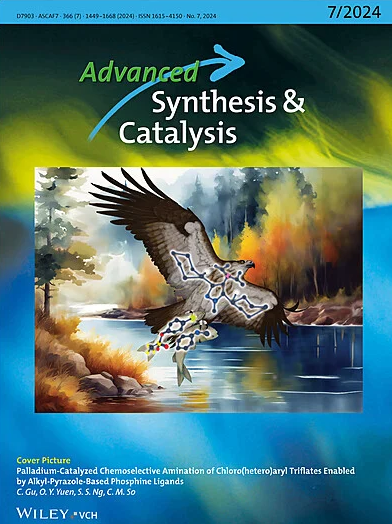Diaryliodonium Salt‐Mediated Radical Transformation of Indoles with Alcohols for the Synthesis of Unsymmetrical Bis(indolyl)methanes
IF 4.4
2区 化学
Q2 CHEMISTRY, APPLIED
引用次数: 0
Abstract
A method for the synthesis of unsymmetrical bis(indolyl)methanes (BIMs) using simple indoles and readily available alcohols as the coupling partners under both heat and 390–400 nm light conditions was developed. Detailed research of the mechanism demonstrated that the diaryliodonium salt‐mediated transformation undergoes a nucleophilic hydroxymethyl radical formation process. Moreover, the diaryliodonium salt‐mediated method is also applicable for synthesizing symmetrical BIMs.

二迭碘鎓盐介导的吲哚与醇的自由基转化,用于合成不对称的双(吲哚基)甲烷
本研究开发了一种在加热和 390-400 纳米波长的光照条件下使用简单吲哚和易得醇作为偶联剂合成非对称双(吲哚基)甲烷(BIMs)的方法。对其机理的详细研究表明,双十二烷基碘鎓盐介导的转化经历了一个亲核羟甲基自由基的形成过程。此外,二芳碘鎓盐介导的方法也适用于合成对称的 BIMs。
本文章由计算机程序翻译,如有差异,请以英文原文为准。
求助全文
约1分钟内获得全文
求助全文
来源期刊

Advanced Synthesis & Catalysis
化学-应用化学
CiteScore
9.40
自引率
7.40%
发文量
447
审稿时长
1.8 months
期刊介绍:
Advanced Synthesis & Catalysis (ASC) is the leading primary journal in organic, organometallic, and applied chemistry.
The high impact of ASC can be attributed to the unique focus of the journal, which publishes exciting new results from academic and industrial labs on efficient, practical, and environmentally friendly organic synthesis. While homogeneous, heterogeneous, organic, and enzyme catalysis are key technologies to achieve green synthesis, significant contributions to the same goal by synthesis design, reaction techniques, flow chemistry, and continuous processing, multiphase catalysis, green solvents, catalyst immobilization, and recycling, separation science, and process development are also featured in ASC. The Aims and Scope can be found in the Notice to Authors or on the first page of the table of contents in every issue.
 求助内容:
求助内容: 应助结果提醒方式:
应助结果提醒方式:


